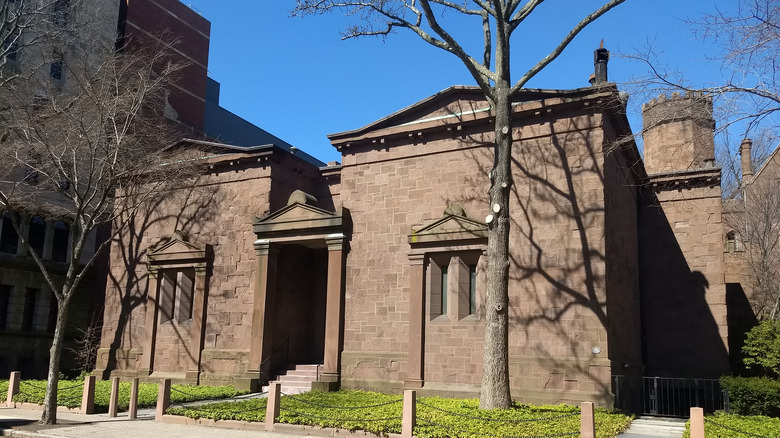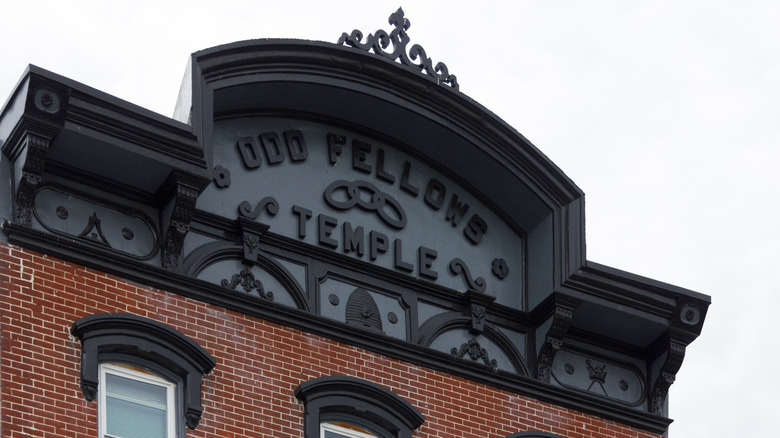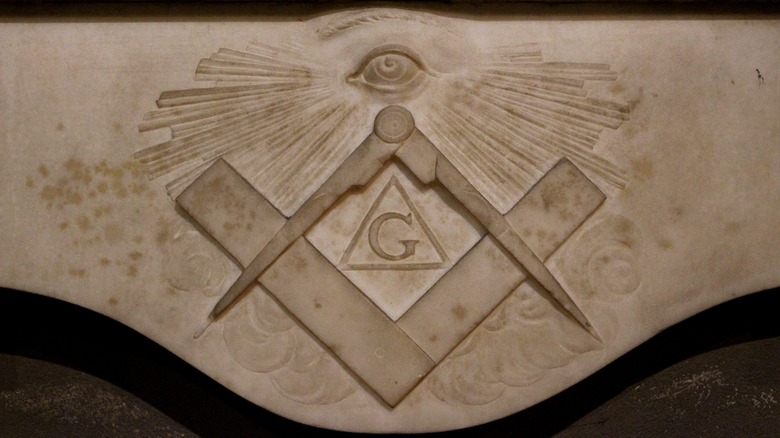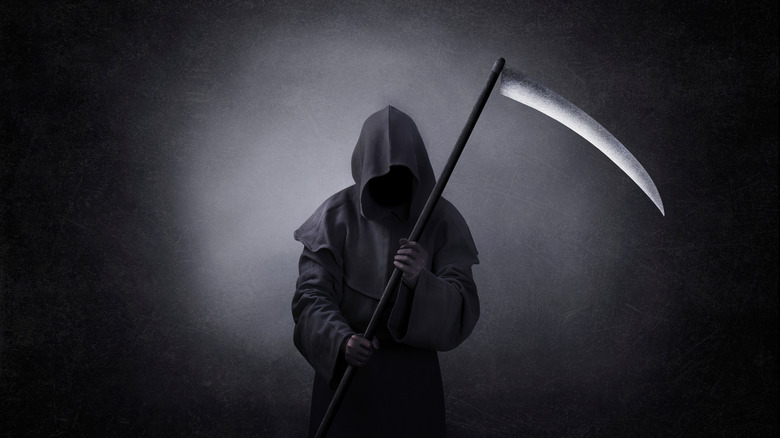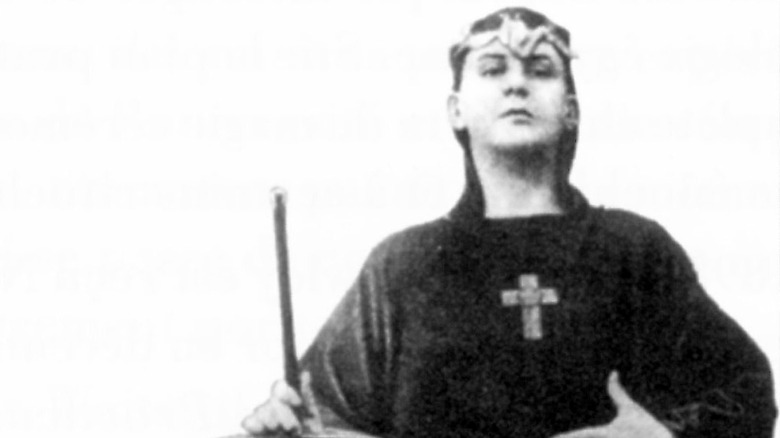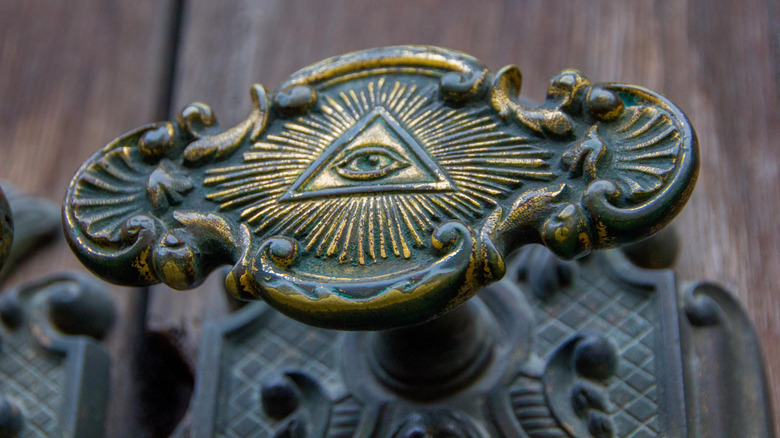Secret Societies That Are Nearly Impossible To Leave
Have you ever passed a Masonic temple that looks like the Parthenon and wondered what goes on in there? Suspected there were motorcycle gangsters hanging out at a local bar? Gazed at a dollar bill and wondered if that eye has anything to do with the Illuminati?
Secret societies have been around almost as long as humanity. While some do cast sinister shadows and are even considered cults (depending on who you ask), others fly under the radar because they would rather not draw media attention. Whether or not members want to, or are allowed to, reveal themselves, what all these organizations have in common is that they hold on to some degree of secrecy. For some, this means never spilling anything about the rituals that go on behind closed curtains. Others require that the identities of their members remain cloaked for life and can only be revealed once those members leave this mortal coil.
Leaving a secret society can be complicated. More lenient societies allow members to leave if they go through a formal process and may eventually allow them back in, but for some, there is no such thing as an ex-member, even if that member disassociates. They maybe harassed for the rest of their lives. Even that is not as punishing as some groups from which there is no way out but an escape just as secret as the society itself. You may be standing next to someone from one of these underworld clubs and never realize it.
Skull and Bones
Yale is known to be crawling with secret societies — but perhaps the one that attracts the most curiosity is Skull and Bones. Membership is only open to seniors who are sworn to absolute secrecy.
Skull and Bones was founded in 1832 and is Yale's oldest and most prestigious secret society, according to a study published in the National Library of Medicine. Bonesmen emerge after sundown, draped in robes as they file into a building known as the "tomb" that could easily pass for a masuoleum. Where the headquarters of Skull and Bones lies is no secret. It is right across from Yale's old campus, which is now a dorm swarming with freshmen. And while the building itself is obvious, what rituals happen within those walls can only be guessed at. Only 15 of the most elite seniors are invited to join every year, but as The Atlantic notes, candidates are able to reject their invites.
The identity of members is hardly a secret. Bonesmen have gone on to positions of power from CEOs to presidents. Included on this famous roster are wealthy families like the Vanderbilts and Rockefellers, as well as presidents William Howard Taft, George H.W. Bush, and George W. Bush.
You're a Bonesman for life after being inducted into Skull and Bones, but it's not like members are called upon to stay active as adults. Those who wear the robes, according to CBS News, transition to elders in "the ultimate boys' club" upon graduation, so club affiliation is more like a badge of honor.
The Independent Order of Odd Fellows
While the name may sound sinister, Odd Fellows was first formed as a brotherhood meant for members to support each other before insurance and government social and welfare programs existed, as their official website states. There is still some oddness lying beneath that.
When exactly this society was founded remains shrouded in mystery. The earliest known Odd Fellows can be traced to 1700, even boasting members such as England's King George IV. There were no rituals in those early days, but that would soon change. Because Odd Fellows sprang up in England before spreading to North America, it was eventually forced into secrecy by the English laws of the time, which made fraternal societies like it criminal because the monarchy feared revolution and unionization (it is thought to be one of the predecessors of labor unions). That is how the passwords and secret handshakes began.
Are there any rituals? Atlas Obscura reports on an abandoned lodge where human bones were discovered in a coffin. It is speculated that the bones are supposed to be a reminder of human mortality. Because Odd Fellow keeps their activities undercover, it is impossible to know whether members can leave voluntarily. There is one tantalizing bit of information. On their website, one lodge admits that membership has plummeted 90% over the last century, and they've noticed as members get older, their numbers have gone down. Does that mean few new members join anymore, and death is the only way out? That same lodge acknowledges that members may withdraw.
The Hell's Angels
Often synonymous with outlaws and organized crime, the Hell's Angels motorcycle club never intended to go down that road. They are really just a brotherhood of bikers who have sometimes found themselves riding on the wrong path.
Where the name "Hell's Angels" came from is debatable, but the club was founded in San Bernardino, California, in 1948, according to the New York Times. Oakland chapter founder Sonny Barger soon rose to the forefront in the late '50s, and by the early '60s, the Angels started going international. Their reputation as rebels started in 1965 when reports of a gang rape surfaced. More crimes would catch fire in the media in the coming decades, including fatal interactions with rival clubs and murder.
The Hell's Angels don't really consider anyone a "former" member. You are either "out in good standing" or "out bad," as once-leading Angel George Christie told Vice. Christie had seen it all, from stints in prison to butting heads with the legendary Barger over whether to join forces with other biker clubs. After he turned his back on the Angels, Christie was initially regarded as being in good standing until his status changed to "out bad," which led to him being slandered and harassed, As Christie told Vice, "I felt we became the people we rebelled against, and that's exactly what I told them at the meeting when I left."
The Knights Templar
Founded by the original Crusaders during the Middle Ages, some say the Knights Templar ceased to exist around 700 years ago, but there are others who say the brotherhood is still alive and well underground.
The Knights Templar were born from a band of knights who swore to protect Christians in Jerusalem, as the History Channel recounts. They were basically fighting monks. Much like actual monks, brothers took vows of poverty, chastity and obedience, though the order itself could acquire money and land without that wealth belonging to any individual knight. The Templars found themselves feuding with other Christian military organizations after Jerusalem was seized by Muslim warriors. As Europe gave up on the Crusades, so did the Templars, and many were charged with crimes such as heresy, fraud, sexual misconduct, and even devil worship.
The Templars definitely had some strange rules. According to History, you couldn't bathe without permission or wear shoes with laces. But could you ditch the order? Unless you died in battle, being expelled for a serious offense like fornication was really the only way out, History says in yet another Templar account. What would happen to a potential defector now is unknown since the brotherhood's existence is debatable. Those who believe they exist think they might guard the Holy Grail. If they really are still around, they are too secretive to reveal any intel on how to join and whether you can leave.
The Freemasons
For a secret society, the Freemasons might be one of the most highly documented, not to mention surrounded by conspiracy theories — though most of what actually happens behind closed doors stays there. They are loath to reveal their secrets.
Freemasonry is thought to have begun as a brotherhood of stonemasons in England and Scotland during the 1500s, according to the History Channel. The society would later evolve as an organization helping its members in business and society, using secret symbols to both protect themselves and acknowledge others, as per The Guardian.
An incident in 1826 showed just would happen if someone tried to bring their clandestine ways to light. As History relates, William Morgan, a New York Stoneworker, threatened to expose some unsavory things that the Freemasons had kept hidden in an upcoming book. He kept running from them. Then he disappeared.
While the Freemasons are often seen as a cult, they are anything but, as National Geographic clears up. The only requirement is that you believe in some higher power. If you've heard the rumor that initiation requires drinking wine from a skull, that is also myth. Members are also not bound for life. You can either obtain permission to leave, known as a demit, or quit paying your dues and wait to be kicked out. As one lodge points out on its website, taking the demit still allows the former member some access, like visiting or affiliating with other lodges.
The Grim Reapers
It seems almost contradictory to think police are in secret societies, especially after so many Hell's Angels arrests, but they do exist. Some have even been caught up in violence.
The Grim Reapers are one of several fraternities that arose from the Los Angeles County Sheriff's Office, as the Los Angeles Times remembers. The Little Devils were first onto the scene in 1971. They were soon followed by the Reapers and other societies whose premise has been to be a support system for officers in an otherwise taxing and traumatic line of work. Unfortunately, some of these groups, like the Lynwood Vikings, tainted the others' reputations when they blew up into notoriously racist and hostile entities. Deputies are discouraged from joining any such brotherhood because, as Joe Hicks, director of the Los Angeles human relations commission, told the Times, "They are generally perceived as rogue cops who have often been accused of acting in very inappropriate ways on the street."
There are other reasons that groups such as the Grim Reapers are side-eyed. The Los Angeleno reveals hazing with another police fraternity, the Banditos, who physically assaulted new members so they would not break their silence about what went on within the organization. Can an officer disassociate from the Reapers? L.A. Sheriff Alex Villanueva's former chief of staff, Larry Del Mese, allegedly admitted it. As he told ABC 7, "I was a member of the Grim Reapers." He also said that he had been tattooed while he was in but later had the tattoo removed.
The Seven Society
If there is a secret university society more clandestine than Skull and Bones, the Seven Society might be it. The identities of this University of Virginia group's members are only revealed after their death, according to Atlas Obscura, and its unknown how they are even chosen. There are even symbolic sevens at their funerals.
Take a stroll around the rotunda of the University of Virginia, and you will probably notice the statue of Thomas Jefferson overlooking a huge number seven with an infinity symbol floating above it and flanked by the Greek letters alpha and omega. As Virginia Living says, the philanthropic organization is thought to have been formed in 1905 when eight students planned to meet up for a bridge game, and they ended up with only seven.
You can't send the Sevens an email, but you can apparently contact them by leaving a letter at the Thomas Jefferson statue. This group is so secretive that whether you can leave is unknown, but, as retired UVA professor Sandy Gilliam told University of Virginia Today, it seems you're in for life.
The Service Employees International Union
The secret about the Service Employees International Union (SEIU) isn't its existence or who its members are, but that many of these members don't even know they belong to it — or that they're paying dues. Who signs them up?
A Wayne University study says the organization was founded in 1921 for service employees from various professions. It used to have a much broader membership that included everyone from doormen to janitors. About half a million Americans now belong to the SEIU, according to The Heritage Foundation. You yourself may be a member and have no idea, since only about a sixth of members are actually aware of their membership. It's likely that if you are a home care provider, $350 of your salary automatically goes to the union every year, though you may be oblivious to it.
That adds up to annual dues of $200 million a year for the organization, with union leaders rewarded handsomely — most of whom work less than 40 hours a week but still earn yearly salaries upwards of a quarter million dollars. Their lavish lifestyles are funded by workers who barely make minimum wage (covered by Medicaid) assisting those who are unable to care for themselves.
You can submit a written request to leave, as one chapter's website claims, but you actually need to know you're a member. As home care provider Robert Haynes told Heritage, "We're not getting anything from them. We've tried to contact them, and they don't even bother to respond. I don't even know what they could do to help."
The Thelemic Temple
Influenced by occultist Aleister Crowley, the Thelemic Temple was inspired by the Freemasons but soon incorporated Crowley's Book of Thelema into its belief system, according to Atlas Obscura. Rumors have always swirled around its rituals, but what goes on in the Temple, stays in the Temple.
When Hidden City Philadelphia interviewed a member who only identified himself by the title Frater Lux ad Mundi, he revealed the reason this society prefers to stay underground — even though meetings with prospects are often hidden in plain sight at a local coffee shop. The reason for all the secrecy that shrouds the Thelemic Temple is to keep out anyone with delusions of grandeur or divinity. While the organization recognizes all humans as divine beings, no individual is more divine than the next, and that can be a problem when they are contacted by a potential member who thinks he's the reincarnation of Crowley himself.
Thelemites are not sworn to secrecy about their membership. However, because it could impact their careers, most choose to keep that part of their lives in the shadows. Frater Lux ad Mundi described the Temple as a "punk-rock expression" of Freemasonry that relies on the effort rather than the money of its members. Expect to be dead to everyone if you leave. Not only are ex-members ostracized when they break their bonds, according to the Thelemic Union's website, but also subject to libel and slander.
NXIVM
Though it is now defunct, the criminal secret society of NXIVM was really more like a mashup of a cult and a pyramid scheme operated until recently. Initiates were branded (literally) by the "master" without anesthesia. It only gets worse from there.
NXIVM was started in the late '90s by self-help guru Keith Raniere under the guise of a self-help organization, according to the New York Times. Referred to as "Vanguard," Raniere offered workshops that included what he called "Executive Success Programs" on the surface, but those who fell deeper and deeper into NXIVM found themselves in proverbial chains they were unable to break. Women were especially vulnerable. They were forced by Raniere to have sex with him and starve themselves so he would find them sexually appealing.
Women who entered NXVIM were required to give their recruiter material that could be used for blackmail if they ever defected. This meant naked photographs and anything else that they would not want publicly released, which often forced them to endure years of torture. The only way out of NXIVM was escape or the arrest of Raniere — whichever came first. Survivor Sarah Edmonson told the Times how she went through an agonizing branding ritual during which she had the organization's symbol seared into her skin after being told to recite the words "Master, please brand me, it would be an honor." Insider reports that Raniere was arrested in 2018, charged with sex trafficking and sentenced to 120 years in prison.
The Illuminati
Who can so much as mention a secret society without at least a fleeting thought of the Illuminati? Their existence may either be deep undercover or the stuff of legend, but if they are operating somewhere, this society is so secretive that it is impossible to know for sure.
Illuminati were not always perceived as the all-seeing eye of some new world order. Founded in Germany in 1776 by law professor Adam Weishaupt, according to the BBC, the Order of the Illuminati started out as a movement of opposition against overbearing religious influence and political abuse of power. Another order inspired by the Freemasons (which may be the reason why they are so often associated with them in conspiracy theories), it created safe spaces for people who felt shackled by government and religion. Despite what sounds like a cry for revolution, Weishaupt only wanted to inspire people to learn everything they possibly could to push for change in the world. He had no idea what outside concepts of his organization would eventually blow up into.
Some believe that the real Illuminati began far before Weishaupt, as the Guardian says, and left their mark on everything from the pyramids of Egypt to the eerie Eye of Providence that gazes back at you from a dollar bill. Nobody knows if you can leave — obviously, since the existence of the organization itself is unknown.

